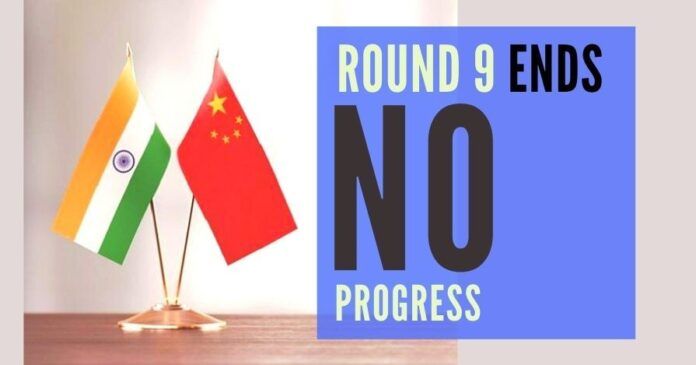
The ninth round of military-level talks between India ended with no breakthrough
Nothing significant evolved in the ninth round of military-level talks between India and China on Sunday, except to decide to meet further to settle the tussles through dialogue and find mutually accepted agreements to disengage and de-escalate. According to defence experts, India and China “held the ninth round of military-level talks on Sunday to defuse tension at the Line of Actual Control (LAC) in Ladakh and re-affirmed their commitment to resolve the issue through dialogue.” There was no breakthrough but both the sides agreed to meet soon to find mutually acceptable agreement to disengage and deescalate, they said.
The parleys lasting more than seven hours beginning at 10.00 am between the Corps Commanders of the two armies was held at Chushul-Modo border meeting point on the LAC in Ladakh. The Indian side was led by 14 Corps chief Lt General P K Menon and the delegation also included a joint secretary from the ministry of external affairs. There already had six rounds of the diplomatic level talks under the aegis of the Working Mechanism for Consultation and Coordination (WMCC) were also held since the face-offs began between the two armies in May last year. However, these interventions also failed to end the impasse. The last WMCC talks were held on December 18.
The Indian Army and IAF have deployed its frontline troops and fighter jets at all the important forward bases all along the 4,000 km long LAC.
The latest round of Corps Commander talks came more than two months after the eighth round was held on November 6 between the two Commanders. While no positive result came out from the latest episode, both the sides focused on thrashing out a mutually acceptable timeline for disengagement from friction points and ultimate de-escalation, sources said here on Sunday. In a joint statement issued after the last round of talks, the two countries agreed to implement the “important consensus reached by the leaders of the two countries, ensure their frontline troops exercise restraint and avoid misunderstanding and miscalculation.” The two Commanders on Sunday took stock of this agreement and decided to sustain it till an amicable solution was found, officials said.
“Though reiterating its stand on finding a way out through dialogue, India was not taking any chances. In this backdrop, it had so far turned down the Chinese insistence on withdrawing its troops from strategic heights on the south and north banks of the Pangong Tso (lake). Instead, India in all the rounds held so far stuck to its stand that China had to first withdraw its troops from all the friction points including ‘Finger 4 to 8’ at the same time. The Chinese have intruded more than four km in this region near the Pangong Lake. Moreover, India was of the firm view that China had to reduce its troop strength in-depth areas besides tanks and artillery guns,” said defence experts, analysing the situation of tussles going on between India and China from April 2020.
At present, more than one lakh troops from both sides were facing each other at the 1,700 km long LAC in Ladakh. Moreover, the entire LAC from the west in Ladakh to Arunachal Pradesh in the east was on heightened alert. The Indian Army and IAF have deployed its frontline troops and fighter jets at all the important forward bases all along the 4,000 km long LAC.
Indian Air Force (IAF) chief R K S Bhadauria on Saturday had said if China opted for an aggressive stance in Eastern Ladakh, “we can also be aggressive.” The Indian troops were braving the harsh winter in Ladakh with the temperature dipping to minus 30 degrees now. In order to sustain them and keep them operationally ready, the Army has an adequate number of winter clothing and prefabricated heated huts. Moreover, local commanders were regularly reviewing the logistical position.
- NIA confiscates Pak-harboured Khalistani terrorist Lakhbir Singh Rode’s key aide’s land in Moga - April 19, 2024
- Prime Minister Narendra Modi: A Gujju businessman who does not invest his precious time for a losing battle - April 13, 2024
- NIA arrests two accused Shazib and Taahaa in Bengaluru’s Rameshwaram Cafe blast case from Kolkata - April 12, 2024











[…] खबर को अंग्रेजी में यहाँ […]
the communists never follow any reason and ethicks. Their policy is ” might is right”. and brutal might is the law. There is no exception either to ex USSR and present People Republic China. Especially the China policy is salamy slicing . This approach, China has been following when the Congress starting from Nehru , Indira, Rajeev and UPA government were under ruling as the leadership was very weak at that time. China has expected the same obidience from Modi government. Despite it’s miscalculation during Doklam, still , China is thinking it’s pressure tactics and milatary might would certainly force India to yield . The days have been changed , today ‘s India is not yester decades India with a weak , aimless and visionless leadership. China would be really disappointed with the coming generation leadership starting from Modi , who are very assertive and unyielding and for them , Country is first . Modi, our defence forces, and the public are united to deal with any aggressive posture by our neighbours and the time has come to get back our land from their hands.